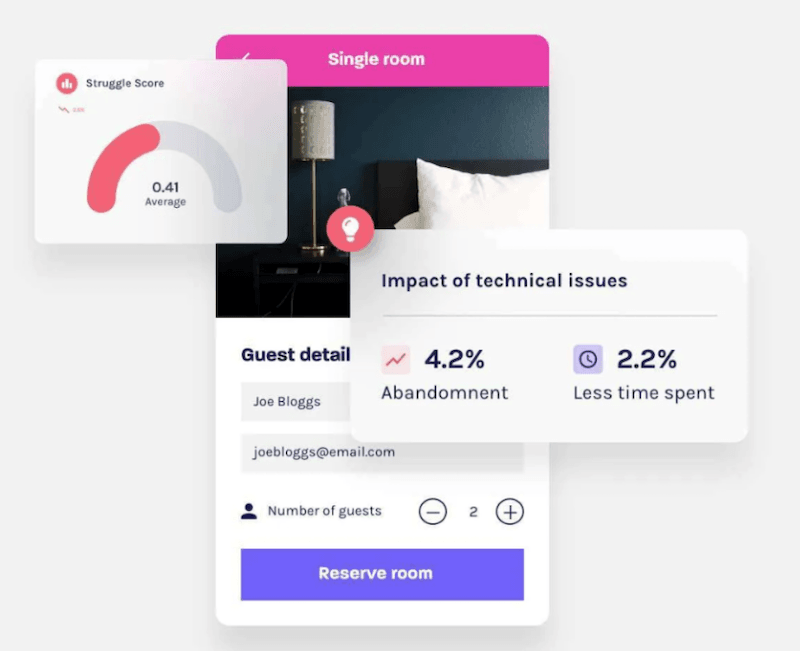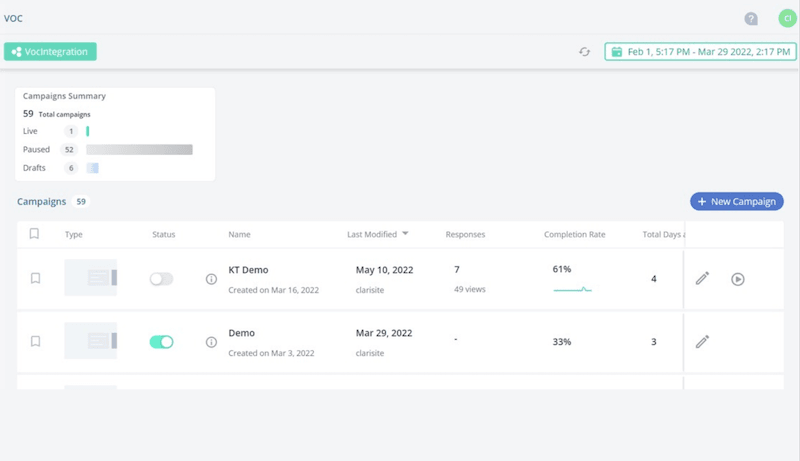Updated: April 25, 2024- 9 min read
A new product launch can cost anywhere from $10,000 to $10 million*. That’s a lot at stake, whether you’re a startup or big business. Everything needs to be perfectly harmonized, from design to GTM strategy to marketing to distribution. It’s your first and only chance to make the right impression on your target market. But there’s a key element product managers can integrate into their product launch plans that will increase the chances of a successful launch: digital experience intelligence (DXI).
Let’s take a deep dive into how you can enrich every part of the product launch and beyond with DXI.
Key takeaways
Ask the right questions to get your product launch on the right path
Learn how digital experience intelligence enhances a product launch
Discover eight hands-on strategies to use DXI for your next launch
The foundation of successful product launches
A well-executed product launch can be the catalyst to accelerate early adoption, increase revenue, and improve brand credibility. For product managers and stakeholder teams, these outcomes are the result of thorough planning and meticulous execution.
Here are some important questions to consider when planning your launch:
Is it solving a specific problem for customers? There’s no such thing as solving a problem that doesn’t exist (even with a marketing spin). Nor should a product try to be all things to all people. Your product should help consumers solve an identified problem that could have a major impact. And it’s not just a feature of an existing product–it brings specific and outstanding innovation.
Have you done your product research? Product research is a key step in the product launch process to validate that building a new product will be worth the investment of time, budget, and resources. Usability testing and focus group research provide valuable insights into customer interaction with the product, feedback on what works and needs improvement, and help course correct as needed.
Are you positioning the product correctly? You might have a product that works perfectly, but it could easily be ignored if it’s not spot on with positioning in the market and for your target audience. That’s why it’s always relevant to run through the three C’s of product positioning–customers, competition, and company.
Do you know your buyer personas inside and out? Your positioning should align with your target market, including their needs, values, demographics, price threshold and other important criteria. Once you deeply understand their requirements and preferences, you can create targeted value propositions, messaging, marketing and content to resonate with them best.
How do you stack up against the competition? Beyond differentiating your product in design and features, you should deeply understand your competitors–their market share, pricing, branding, promotional strategies, and other competitive intelligence.
Is the timing right? The old cliché is true: timing iseverything, especially throughout the product launch process, both externally and internally. There should be a pent-up consumer demand or strong indication from product research that the time is right for the launch. In preparation, a beta test can gauge performance and address any issues. Of course, the product development team should resolve issues so there aren’t missed problems on the go-live date.
Are all teams ready for launch? Prior to the product launch, all the stakeholder teams should be 100% ready for the launch date. That means all stakeholder teams, from product marketing, sales, support, PR, marketing teams, and other groups, should have the training they need prior to launch. Collaborating closely to find gaps in messaging, timing, or other planning elements is invaluable to get the launch right.
The product launch process
While this is by no means a complete list of key considerations, these are some of the major elements to prime for product launch success.
To increase the possibilities of a successful product, digital experience intelligence is fast becoming the most efficient way to maximize the power of insights before, during, and after the launch. This powerful set of tools captures, analyzes, and delivers insights about your customer interactions.
Harnessing digital experience intelligence for product launches
A digital experience intelligence platform provides rich insights that give you a complete picture of what your customers are doing and the critical data to uncover why they’re behaving that way, unlike standalone product analytics tools that can’t provide the complete picture. DXI platforms combine data from product analytics, heatmaps, session replay, customer journey analytics, and other analytics tools.

Below are some key areas that product managers can use to enrich their product launch strategy and planning.
Product analytics collects, analyzes, and interprets data about how users interact with your product. This data can be used to improve the product by identifying areas where users are struggling, finding ways to make the product more user-friendly, and tracking the effectiveness of changes that have been made.
Performance analytics measures performance variables like functionality, reachability, and responsiveness. Leveraging real user monitoring (RUM), a variety ofperformance metrics can be measured based on real-time user interaction with a website or native mobile app.
Behavioral analytics captures and analyzes how visitors behave on websites, apps, and other digital experiences based on their actions (and inactions). With behavioral analytics you can capture metrics such as: how long a user stays on a page or screen, individual elements they interact with, and specific actions they take.
Digital analytics is an umbrella term for the tools and processes used to collect, measure, analyze, and interpret behavioral data–essentially, how prospects and customers interact with your product and brand. It can encompass data across a wide range of digital sources, such as websites, mobile apps, email campaigns, social media channels, and customer interactions.
Voice of the customer (VoC) analytics tells you exactly what your customers and users are thinking. Extracting meaningful insights from VoC surveys tells you why a customer is dissatisfied and how many users are affected by the issue, or how and why a customer is delighted and how to replicate that experience, for example. You can also correlate other analytics with customer sentiment for a more complete picture..
Customer journey analytics is the process of gathering and analyzing key data points of the customer experience across every touchpoint in the customer journey. These analytics combine a variety of data sources and contextualized visualizations. This data reveals customer behaviors and is used to guide decisions on where and how to improve the digital experience.
A digital experience intelligence platform combines all of this data into a single source of truth and provides advanced insights to help product managers make data-driven decisions.
The route to success: 8 strategies for mastering product launches using digital experience intelligence
DXI has proven to be a powerful tool to strengthen product launches, delivering advanced insights that enrich data-driven strategies and key decision-making.
Product managers can leverage these eight strategies at different points during and post product launch to measure and improve results.
1. Conduct market research and audience analysis
Gather and analyze data from your digital channels like websites and mobile apps. DXI helps you understand and gain insights about market trends, consumer preferences, and audience behaviors.
Identify customer segments that may have different needs and expectations. DXI can provide the insights to help customize a tailor-made approach to the launch, building personas.
Research can also provide you with new ideas about how the product’s features can be further adapted to deliver better experiences.
2. Gather and analyze actionable customer feedback
Collect actionable feedback through voice of customer (VoC) tools. Integrated with a DXI platform, customer feedback is easily captured to individual customer journeys so you can discover even more insights from your audiences.
Analyze data to identify themes and trends. Surface-level analysis isn’t enough–going deeper can lead to even more useful behavioral and interaction insights.

3. Run personalized marketing campaigns
Leverage advanced DXI insights based on digital behaviors and preferences to segment customers and profile users.
Create marketing campaigns personalized for specific segments that can help increase engagement and conversion rates.
4. Optimize the customer journey
Find user pain points, struggle areas, and opportunities for improvement in the website and app customer journey.
Proactively find issues prior to the product launch by optimizing the customer journey and user experience
Customer journey maps visually detail every path customers take and which ones are most effective.
Struggle analysis instantly shows user interactions that are causing users difficulty.
Funnel analysis reveals how user issues impact engagement and conversions.
Session replay shows the actual customer interaction with your product (while ensuring user privacy).
5. Real-time performance monitoring
Detect any performance issues or downtime through digital experience intelligence tools to monitor website and app performance in real time.
Prioritize issues quickly and address these issues based on business impact to minimize disruptions for users
6. Post-launch analysis and iteration
Provide valuable DXI insights into user behavior, adoption rates, and customer satisfaction.
Use insights to iterate on the product, and introduce new features or improvements based on customer feedback.
7. Measure product launch success
Combine customer journey analytics, conversion data, and other insights to quantify the success of product launch efforts.
Develop rationale based on data analysis to increase resources allocated to the product launch.
Inform decisions for future product launches based on insights.
8. Improve post-launch customer retention and loyalty efforts
Track customer retention rates and identify factors that contribute to return buyers and long-term loyalty.
Monitor customer churn and proactively improve problem areas to mitigate customer turnover.
Implement strategies to retain and nurture existing customers post-product launch.
Final thoughts
Digital experience intelligence delivers a range of powerful benefits for product teams to optimize their launch strategies in real-time. Integrating DXI as a part of the product launch process increases the chances of a successful launch and future planning.
Learn more about how Glassbox can help you enrich your product launch today.
Are you attending ProductCon 2023 in San Francisco? Swing by the Glassbox booth to see how digital experience intelligence can help you master your next product launch.
*Data based on November 2022 article
Updated: April 25, 2024




